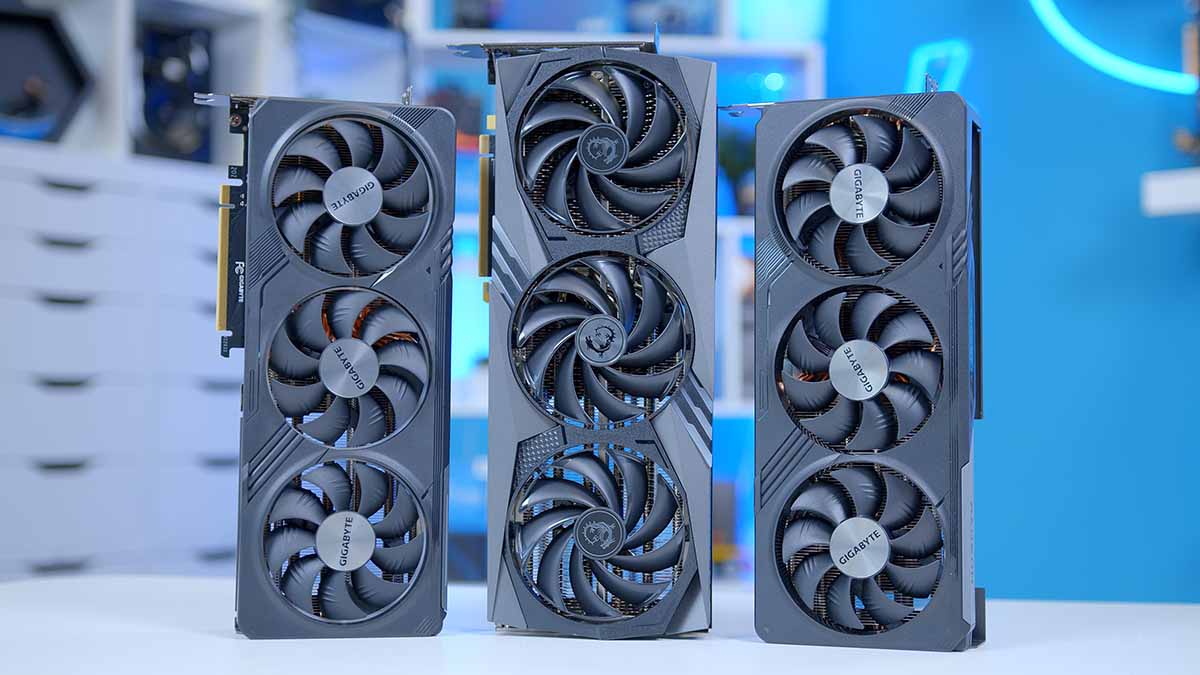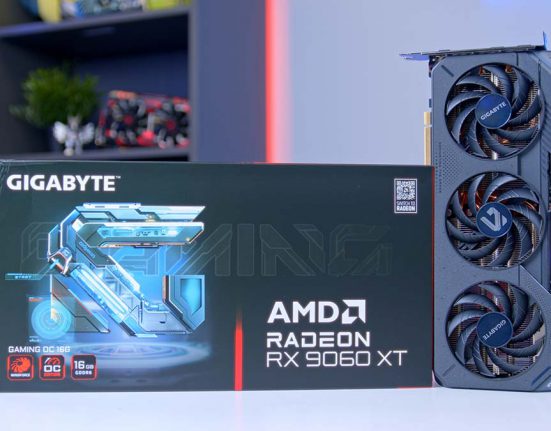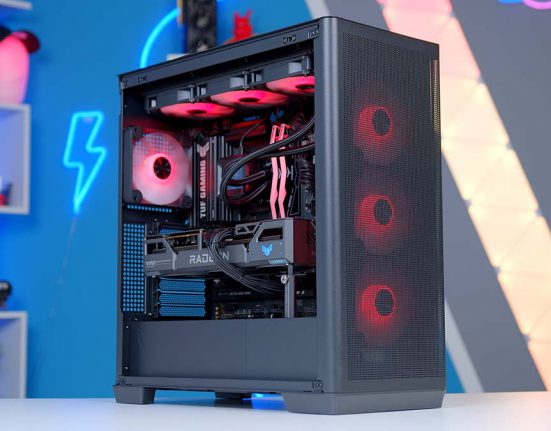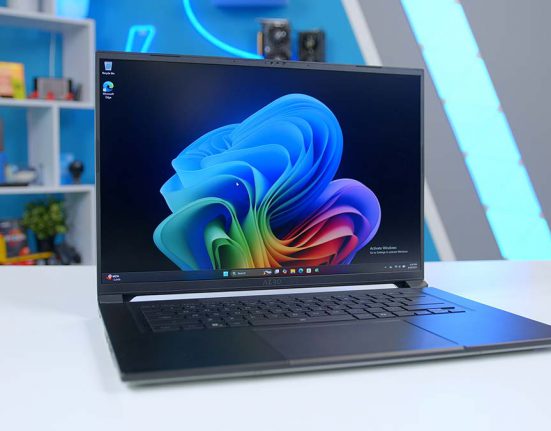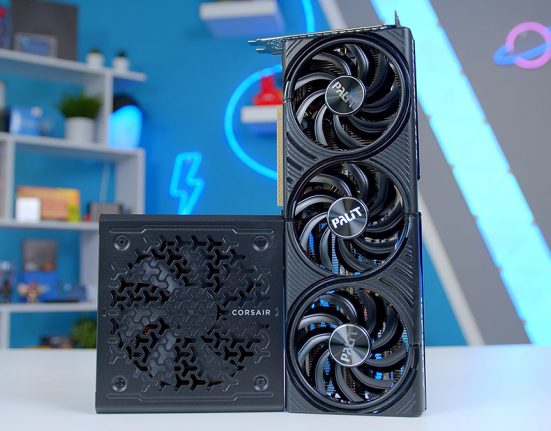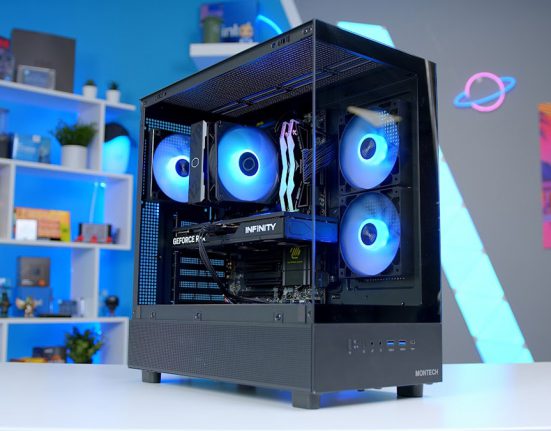When buying a GPU, it can be challenging to distinguish where each GPU lies when ordered from most to least powerful, let alone where one GPU ranks against another on the value for money front, VRAM amount, or features available to you. That’s why, as part of our recent GPU Buyer’s Guide video, we’ve compiled a list of the latest GPUs ranked from least to most powerful so you can gauge which card is the best buy.
The table below also includes the launch MSRP for each model. However, it should be noted that accurate availability figures fluctuate regularly and that subsequent post-launch price drops, especially from AMD, make some cards a significantly better value buy now than the day they initially launched.
| Model Name | Launch MSRP | Our Rating |
|---|---|---|
| Intel ARC A380 | $139 | 2.0/5 |
| AMD Radeon RX 6500 XT | $199 | 2.5/5 |
| NVIDIA GeForce RTX 3050 | $249 | 3.8/5 |
| Intel ARC A750 | $249 | 3.5/5 |
| AMD Radeon RX 6600 | $329 | 3.8/5 |
| AMD Radeon RX 6600 XT | $379 | 4.0/5 |
| AMD Radeon RX 6650 XT | $399 | 3.8/5 |
| NVIDIA GeForce RTX 3060 | $329 | 4.5/5 |
| NVIDIA GeForce RTX 4060 | $299 | 2.5/5 |
| AMD Radeon RX 6700 XT | $479 | 4.2/5 |
| NVIDIA GeForce RTX 3060 Ti | $399 | 3.8/5 |
| NVIDIA GeForce RTX 4060 Ti 8GB | $399 | 3.1/5 |
| AMD Radeon RX 7600 | $269 | 4.5/5 |
| AMD Radeon RX 7600 XT | $329 | 3.3/5 |
| Intel ARC A770 8GB | $329 | 2.3/5 |
| Intel ARC A770 16GB | $349 | 2.7/5 |
| NVIDIA GeForce RTX 4060 Ti 16GB | $499 | 2.5/5 |
| AMD Radeon RX 6750 XT | $549 | 4.5/5 |
| NVIDIA GeForce RTX 3070 | $499 | 4.3/5 |
| AMD Radeon RX 6800 | $579 | 4.2/5 |
| NVIDIA GeForce RTX 3070 Ti | $599 | 3.7/5 |
| AMD Radeon RX 7700 XT | $449 | 4.0/5 |
| AMD Radeon RX 6800 XT | $649 | 4.4/5 |
| NVIDIA GeForce RTX 3080 | $699 | 4.2/5 |
| AMD Radeon RX 7800 XT | $499 | 4.4/5 |
| NVIDIA GeForce RTX 3080 Ti | $1199 | 4.5/5 |
| NVIDIA GeForce RTX 4070 | $599 | 4.3/5 |
| NVIDIA GeForce RTX 4070 SUPER | $599 | 4.0/5 |
| AMD Radeon RX 7900 GRE | $549 | 4.6/5 |
| NVIDIA GeForce RTX 4070 Ti | $799 | 3.4/5 |
| NVIDIA GeForce RTX 4070 Ti SUPER | $799 | 4.0/5 |
| AMD Radeon RX 6900 XT | $999 | 3.6/5 |
| NVIDIA GeForce RTX 3090 | $1499 | 4.3/5 |
| AMD Radeon RX 6950 XT | $1099 | 3.9/5 |
| NVIDIA GeForce RTX 3090 Ti | $1999 | 4/5 |
| AMD Radeon RX 7900 XT | $899 | 3.7/5 |
| NVIDIA GeForce RTX 4080 | $1099 | 4.1/5 |
| AMD Radeon RX 7900 XTX | $999 | 4.5/5 |
| NVIDIA GeForce RTX 4080 SUPER | $999 | 4.1/5 |
| NVIDIA GeForce RTX 4090 | $1599 | 4.1/5 |
Differences Between AMD, NVIDIA & Intel
While price is often a primary consideration for prospective buyers picking up a graphics card, there are inherent advantages to picking up a card from a specific manufacturer. We’ve discussed the main differences between each card below.
NVIDIA Graphics Cards
NVIDIA graphics cards (or Team Green) dominate most of the market share for gamers and workstation systems. NVIDIA cards are so prevalent due to their longevity in modern games and solid driver performance.
The Steam Hardware Survey shows that the RTX 3060 is the most popular desktop graphics card as of April 2024. This is followed by nine more older generation graphics cards (GTX 1000 and RTX 2000) until we see a modern GPU, the RTX 4060 (which is a card that wasn’t received with significant praise). This demonstrates how strong these cards are despite some being over six years old.
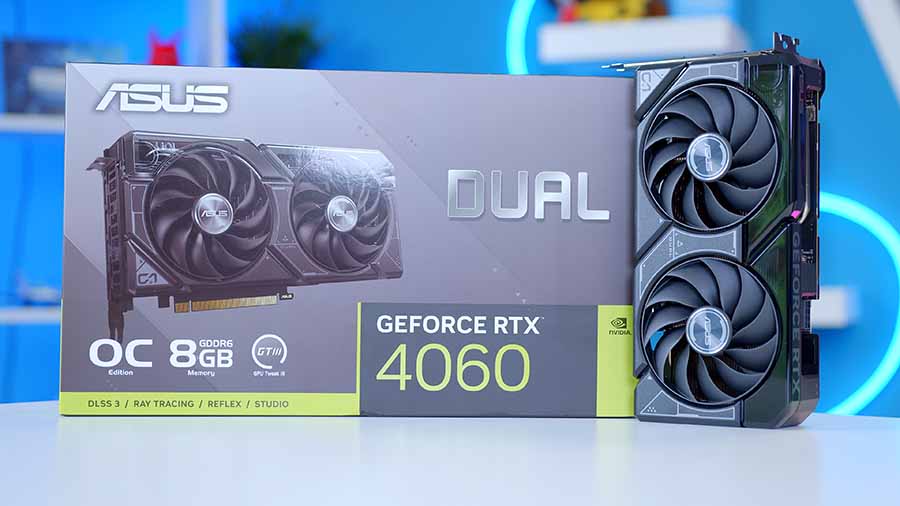
Additionally, NVIDIA has years of experience creating graphical drivers. After acquiring 3dfx, a pioneer of graphical performance in the 1990s, NVIDIA started producing their own desktop GPUs shortly afterwards. This means they have over 20 years of experience creating drivers for modern games, and across our testing, NVIDIA cards are incredibly reliable and tend to cause the least amount of issues concerning crashing or poor performance.
Furthermore, NVIDIA’s advancements in AI and computational power make them stand out from a technology point of view. For example, picking up an RTX 4000 graphics card allows prospective buyers to leverage DLSS, Frame Generation, and excellent ray tracing performance. We’ll cover these details later on, but all of these technologies are specific to NVIDIA, so picking up a Team Green card has benefits.
AMD Graphics Cards
Although AMD has been struggling to sell graphics cards, as shown by their quarterly earnings report, AMD has been the value king of the GPU space for quite some time. AMD cards have always been a great option if you’re looking to save some money. GPUs like the RX 580, RX 6650 XT, and RX 6750 XT are particularly noteworthy cards, as they offer exceptional value while coming in at a very affordable price compared to their NVIDIA counterparts.
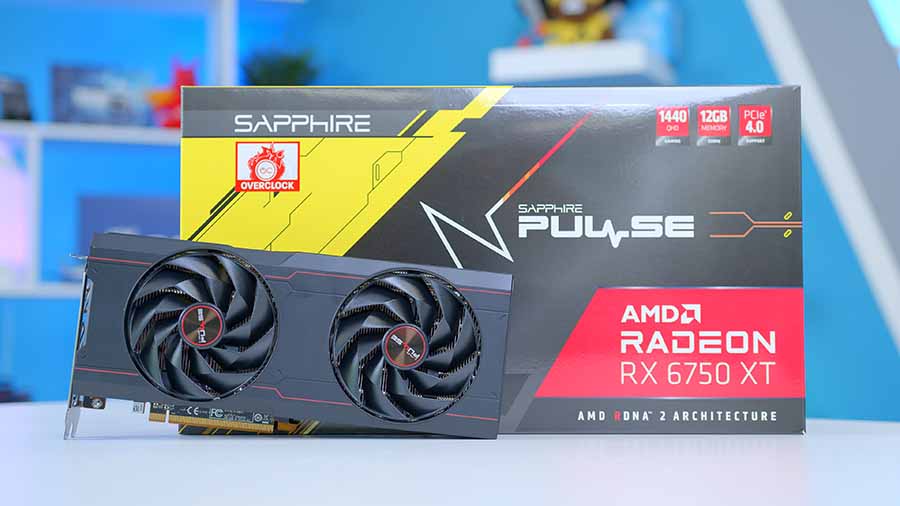
On the other hand, drivers have not always been a key strength for Team Red. While their modern Radeon 6000 cards onwards are on an even playing field with NVIDIA, previous generation cards were plagued with driver problems that made AMD cards a pretty hard sell compared to Team Green, hence why GTX 1000 and RTX 2000 dominated the market during these driver-related issues.
However, since the release of the Radeon 6000 range, AMD graphics cards have remained excellent value options that offer comparable and sometimes better-rasterised performance while coming in at a considerably lower price than NVIDIA alternatives. On top of this, AMD offers competitor technologies such as FSR and Fluid Motion Frames, which target DLSS and Frame Generation to stabilise and bolster framerates. And while these technologies aren’t quite as strong as NVIDIA’s, they’re not incredibly far behind.
Intel Graphics Cards
Intel (or Team Blue) are the outlier in the graphics card space. It was only until very recently (2022) that Intel offered discrete graphics cards for desktop machines, with the launch of their Arc A750 and A770 hitting the shelves first. As can be expected, these cards weren’t very good when they first entered the market. The drivers couldn’t hold a candle to NVIDIA or AMD, and performance was very hit-and-miss across all of the DirectX APIs.
However, with time and experience, Intel has continued to improve drivers and general performance, subsequently bettering framerates and minimising bugs. This means older games are much more playable and have fewer hardware problems. It must be said that these issues weren’t fixed overnight; it’s taken nearly two years for Intel cards to get to their current state, and even with the performance improvements, they still aren’t better than NVIDIA or AMD GPUs.
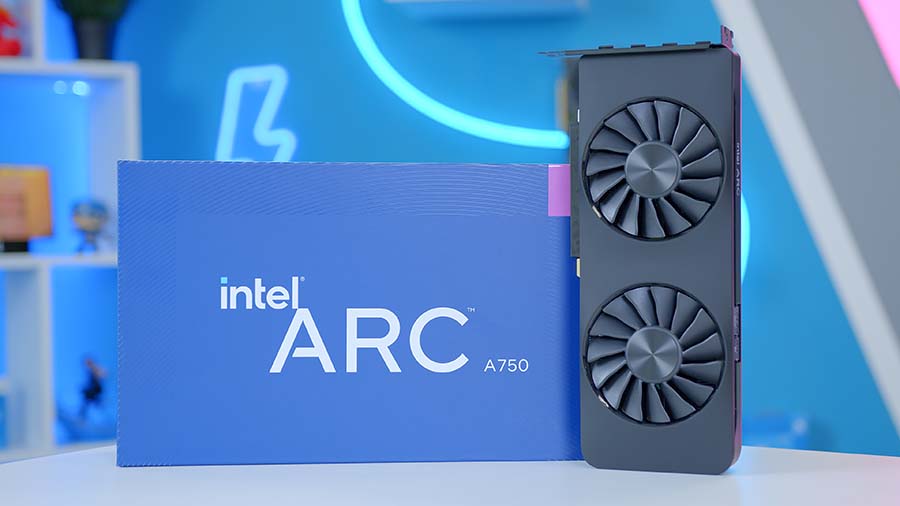
The price is the main advantage of picking up an Arc card versus AMD or NVIDIA. All Arc series GPUs are available for well under $300, and their most powerful (the A770) is available for $279.99 at the time of writing. Intel GPUs are true budget options worth considering for experienced builders looking to save money. However, Intel has a long way to go regarding performance before they are deemed significant competition to the AMD and NVIDIA duopoly.
FSR vs DLSS
While NVIDIA and AMD graphics cards have distinct advantages when looking at hardware and pricing alone, these manufacturers offer technologies designed to bolster and stabilise framerates in your favourite games. This is known as DLSS for NVIDIA; for AMD, this is FSR. We’ve covered both pillar technologies in detail in our What is DLSS and What is Fluid Motion Frames articles, but we’ll briefly cover the distinct differences here.
NVIDIA DLSS
Starting with DLSS, or Deep Learning Super Sampling, this tech arrived as part of the RTX 2000 range of graphics cards. With NVIDIA’s significant breakthroughs in AI, DLSS is designed to uplift framerates through redrawing pixels. The AI has been trained to render gamers at a lower resolution than your screen and then upscale it using the AI. This takes away performance overhead from the graphics card while improving visual fidelity.
DLSS has significantly evolved in the wake of RTX 4000, with the AI now capable of redrawing entire frames instead of just pixels, further improving framerates. NVIDIA’s DLSS is a game-changer in supported titles, and across our testing, the improvement to framerates with less powerful cards is significantly noticeable. However, the most significant limitation of this tech is that it only works in a range of games, so not every title is supported. This will improve over time, but there are only a handful of games where DLSS can be fully utilised.
AMD FSR
FSR, or FidelityX Super Resolution is AMD’s competition to DLSS. This technology was launched in 2021 as an open-source image quality toolkit for game developers to upscale and improve framerates using asynchronous computing power. FSR uses an algorithm to render a game at a lower resolution than your display and then upscales it back to native to improve framerates.
The main difference between DLSS and FSR is that the latter doesn’t use any form of AI to regenerate pixels or frames. Image quality is generally weaker with FSR than DLSS, but the performance improvements are still solid.
Because FSR is an open-source technology, there are no restrictions on which graphics card needs to be used. So whether you’ve got an older AMD graphics card, Intel, or NVIDIA GPU, FSR works in games that support it. As a small note, Fluid Motion Frames (a competitor to Frame Generation) is restricted to Radeon 6000 and Radeon 7000 graphics cards.
Ray Tracing
It’s worth briefly discussing the state of ray tracing with current graphics cards, as many modern titles have come to support this technology to improve visual fidelity and lighting quality. Unfortunately, NVIDIA is the only manufacturer capable of handling ray tracing. While ray tracing technology is still developing, NVIDIA has made major improvements to their current generation of graphics cards to deal with the performance overhead that comes with this tech.
This means that the only cards that can handle the demands of ray tracing technology are RTX 4000 graphics cards. While AMD and Intel have made attempts to improve ray traced performance with their latest GPUs, NVIDIA is miles ahead in comparison.
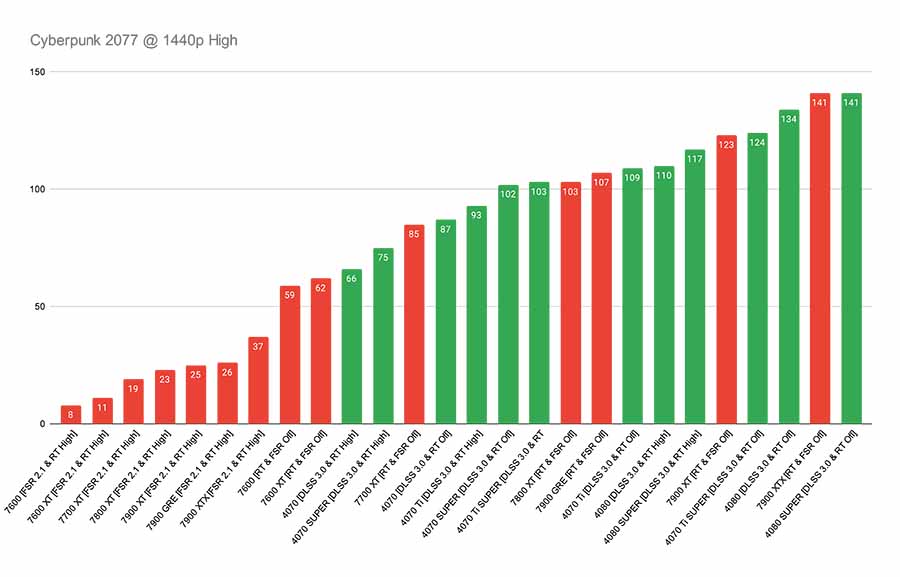
Suppose we look at some of our testing data for Cyberpunk 2077 at 1440p. AMD cards thrive in rasterised performance, with the likes of the RX 7800 XT beating out the RTX 4070 Ti SUPER even when DLSS and ray tracing are switched on. However, as soon as we turn on ray tracing and FSR for the AMD cards, framerates absolutely bomb, with the strongest AMD card (the RX 7900 XTX) offering 37FPS on average, which is pretty poor. Does this mean AMD and Intel graphics cards are bad? Not at all, but those looking to play games with ray tracing switched on will need to consider NVIDIA options.
Pricing Changes
As mentioned in the intro, availability and pricing fluctuate rapidly in the graphics card space. While we’re not seeing GPU shortages like during the RTX 3000 range, competitively priced cards tend to get snapped up quickly.
Furthermore, we’ve seen more changes to the pricing of graphics cards in the past couple of years than ever before. To remain competitive, AMD and NVIDIA are constantly slashing MSRPs, which means most new GPUs are highly affordable compared to their original launch prices. We’ve created a table below highlighting the price changes with current generation cards.
| Model Name | MSRP | Current Pricing |
|---|---|---|
| NVIDIA RTX 4060 | $299 | $299 |
| NVIDIA RTX 4060 Ti 8GB | $399 | $399 |
| NVIDIA RTX 4060 Ti 16GB | $499 | $449 |
| NVIDIA RTX 4070 | $599 | $549 |
| NVIDIA RTX 4070 SUPER | $599 | $599 |
| NVIDIA RTX 4070 Ti | $799 | Discontinued |
| NVIDIA RTX 4070 Ti SUPER | $799 | $799 |
| NVIDIA RTX 4080 | $1199 | Discontinued |
| NVIDIA RTX 4080 SUPER | $999 | $999 |
| NVIDIA RTX 4090 | $1599 | $1799 |
| AMD RX 7600 | $269 | $269 |
| AMD RX 7600 XT | $329 | $329 |
| AMD RX 7700 XT | $449 | $399 |
| AMD RX 7800 XT | $499 | $479 |
| AMD RX 7900 GRE | $549 | $549 |
| AMD RX 7900 XT | $899 | $699 |
| AMD RX 7900 XTX | $999 | $929 |
The data in the table shows that the vast majority of the price cuts are for AMD graphics cards. We have seen some slight drops for NVIDIA GPUs, namely the 4060 Ti 16GB, and after the discontinuation of the RTX 4080, the RTX 4080 SUPER launched at $999.
The AMD Radeon 7000 range has seen four cards have their MSRPs slashed, with the RX 7900 XT dropping by about $200. This significantly shifts the value for AMD, as their GPUs are considerably more affordable than their NVIDIA counterparts. While there are inherent benefits to picking up an NVIDIA graphics card, those looking to save some money should consider AMD.


